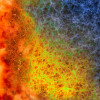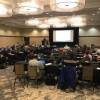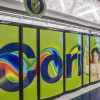Advanced Technologies Research at NERSC
NERSC is more than just a world-class supercomputing facility. Part of its mission is also to enable and support the development of next-generation high performance computing (HPC) technologies and applications that will best serve science needs across the Department of Energy Office of Science and beyond.
Toward this end, NERSC's Advanced Technologies Group engages with other national labs, vendors, and the general research community to help define and evaluate technologies that enhance the effectiveness of HPC for scientific research. One of the group's current goals is to understand what the computing landscape will look like following the end of Moore’s Law and post-exascale. As scientific applications and workflows look to a future that incorporates increasingly data-intensive methodologies such as machine learning, deep learning, and quantum information systems, new opportunities for innovations in HPC system architectures that can increase post-exascale computing capabilities are being heartily debated.
Near term, specializations such as disaggregated architectures that decouple memory from processors and accelerators represent a promising shift that can meet the demands of next-generation workloads by allowing flexible node designs. Further out, we can expect to see semi-custom supercomputing systems targeted at high-value science problems, and heterogeneous integration of advanced semiconductor packaging techniques such as chiplets.
Together, these and multiple other advances will help lead us into the next generation of HPC for science.
For more information, contact:
NERSC Targets Exascale with Perlmutter and the Exascale Science Applications Program
With an eye toward the first generation of exascale computing, in 2021 NERSC unveiled its newest supercomputer, Perlmutter. To ensure that users can readily utilize this next-generation technology, NERSC has been working with development teams to prepare codes for Perlmutter and the coming exascale systems through NESAP. Read More »
2019 DOE Performance Portability Meeting Breaks New Ground
The 2019 DOE Performance, Portability, and Productivity Annual Meeting once again brought together representatives from national labs, academia, and the vendor community to share ideas, progress, and challenges in achieving performance portability across DOE’s current and future supercomputers. Read More »
NERSC, NVIDIA to Partner on Compiler Development for Perlmutter System
NERSC has signed a contract with NVIDIA to enhance GPU compiler capabilities for Berkeley Lab’s next-generation Perlmutter supercomputer. Read More »
National Labs Collaborate to Shape Development of Next-Generation Supercomputers
Three of the Department of Energy's leading national laboratories are working together to solve some of the world's most challenging problems by ensuring that the nation's scientific community has access to leading edge computing systems to carry out their research. Read More »
NERSC Launches Next-Generation Code Optimization Effort
The new NERSC Exascale Science Applications Program (NESAP) is a robust application readiness effort launched to support NERSC’s next-generation supercomputer, Cori Read More »
Berkeley Lab to Collaborate with Intel in Updating Scientific Applications for Manycore Architectures
Lawrence Berkeley National Laboratory has been named an Intel Parallel Computing Center (IPCC), a collaboration with Intel aimed at adapting existing scientific applications to run on future supercomputers built with manycore processors. Such supercomputers will have millions of processor cores, but today’s applications aren’t designed to take advantage of this architecture. Read More »













